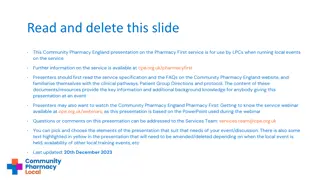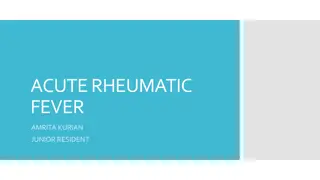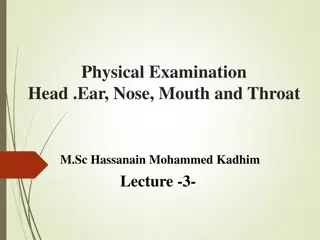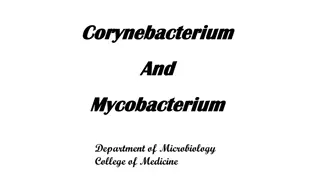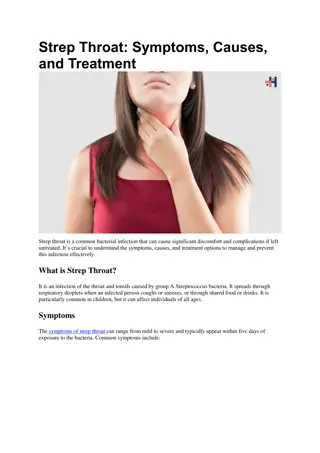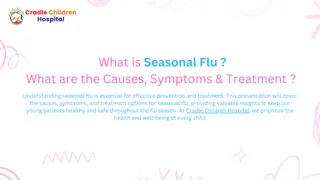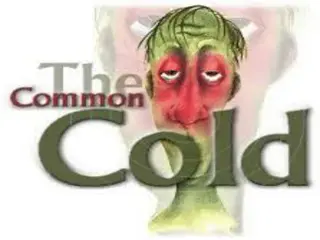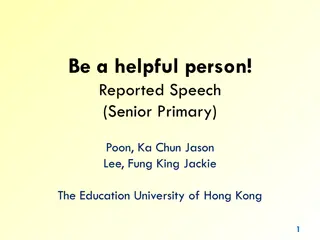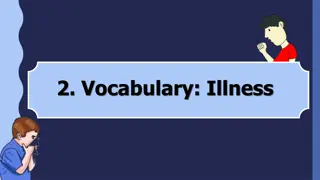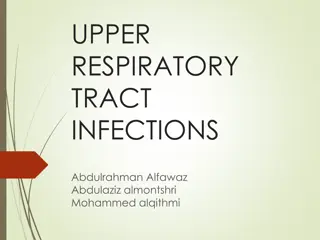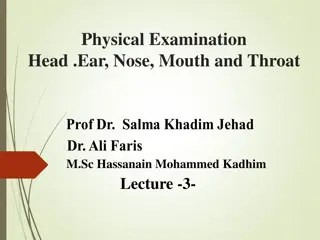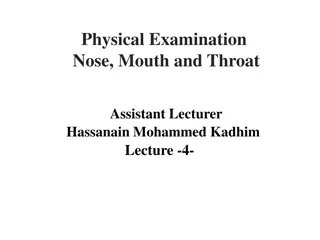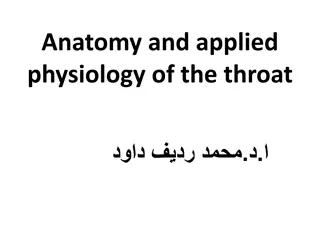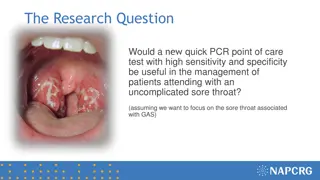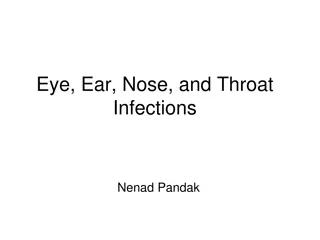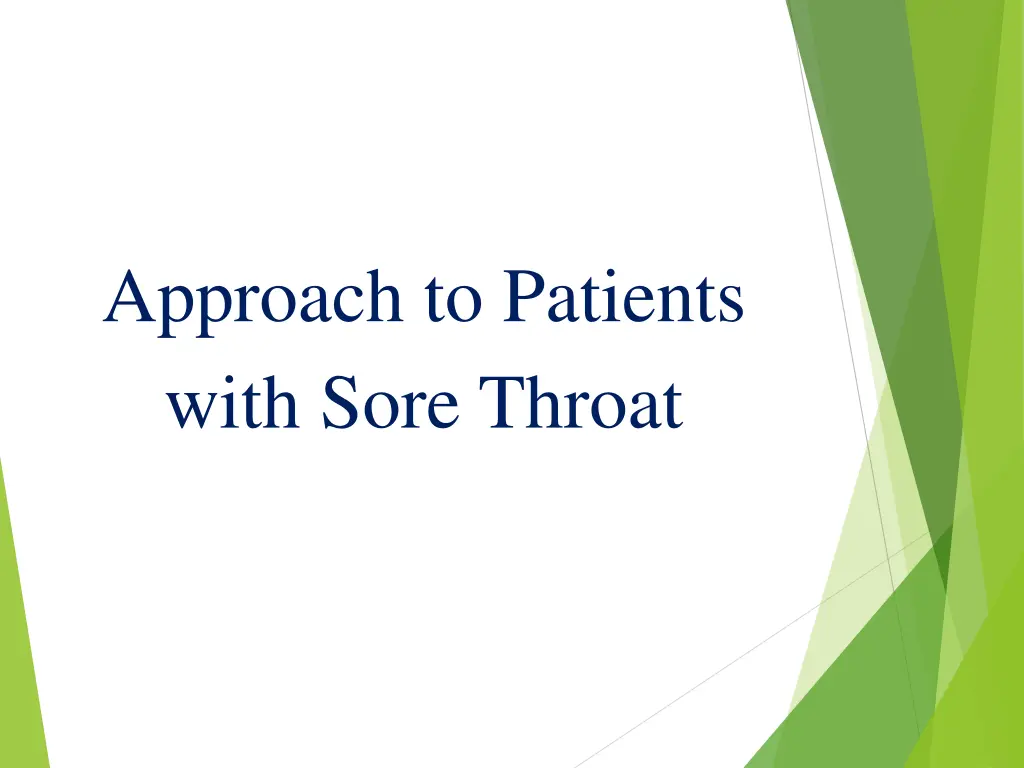
Approach to Patients with Sore Throat: Symptoms, Causes, and Management Options
Discover the causes of sore throat, differentiate between viral and bacterial origins, learn about common symptoms, signs, and management strategies. Explore the case scenario of a college student with a sore throat, and understand the importance of watchful waiting, antibiotics, and referrals to tonsillectomy. Differential diagnosis includes pharyngitis, tonsillitis, epiglottitis, peritonsillar abscess, laryngitis, and GERD.
Download Presentation

Please find below an Image/Link to download the presentation.
The content on the website is provided AS IS for your information and personal use only. It may not be sold, licensed, or shared on other websites without obtaining consent from the author. If you encounter any issues during the download, it is possible that the publisher has removed the file from their server.
You are allowed to download the files provided on this website for personal or commercial use, subject to the condition that they are used lawfully. All files are the property of their respective owners.
The content on the website is provided AS IS for your information and personal use only. It may not be sold, licensed, or shared on other websites without obtaining consent from the author.
E N D
Presentation Transcript
Approach to Patients with Sore Throat
Objectives: Enumerate causes of a case presented with the complaint of sore throat. Identify reasons that led patients to seek help for a sore throat. Differentiate between viral and bacterial causes of sore throat.
Objectives: Discuss the common symptoms and signs of sore throat. Identify different modalities and benefits of investigations in a case of throat. Discuss appropriate management options for a case of sore throat.
Objectives: Discuss appropriate management options for the case mentioned above Identify indications for tonsillectomy.
Objectives: Use the watchful waiting strategies for use of antibiotics and referrals to tonsillectomy. Adopt both modification of help seeking behavior and opportunistic health promotion in such cases.
CASE SCENARIO Khalid is a 20-year old college student. He presents with history of lethargy for 3 days and a sore throat that started today. - He is also having runny nose and mild red itchy eyes. - Throat is so sore that he can hardly swallow solid food. - He does not have any known drug allergies and takes no regular medications.
On examination: - Temperature is 37.8 C, and tonsillar congestion present. - He is well hydrated. There are no other signs or symptoms. - He is anxious about his illness as he is sitting a final 2ndyear exam next week.
Whats Sore Throat? It s a painful inflammation of the mucous membranes lining the pharynx.
-Acute pharyngitis, tonsillitis, or acute exudative tonsillitis may all cause sore throat. These are considered together under the term sore throat .
Differential diagnosis Pharyngitis. Tonsillitis. Epiglottitis. Peritonsillar abscess. Laryngitis. GERD.
Etiology viral cause (50 to 80%), including influenza and primary herpes simplex, Epstein-Barr virus (EBV) Bacterial causes, most common is (GABHS). Others are Chlamydia pneumonia, Mycoplasma pneumonia, Haemophilus influenza, Neisseria meningitides and Neisseria gonorrhoeae (5-36%). Fungal cause, including Candida.
Noninfectious causes: - Irritants - Allergies - Stomach acid GERD - Injuries - Muscle strain - Dryness and - Tumors.
Why are patients seeking help for a sore throat ? A UK study found that only one in 18 episodes of sore throat led to a GP consultation. Practitioners should be aware of underlying psychosocial influences in patients presenting with sore throat.
Why are patients seeking help for a sore throat ? Affecting Function. Relieve the symptoms. Sick leave. Medication Antibiotics . psychosocial factors.
Is it Virus or Bacteria ? The Centor Scoring System may help to differentiate between GABHS and viral causes on the basis of symptoms and clinical signs by categorizing the individual patient s risk level for GABHS infection.
Is it Virus or Bacteria ? The Centor score gives one point each for: Tonsillar exudate Tender anterior cervical lymph nodes History of fever Absence of cough
Centor Score (Modified/McIsaac) for Strep Pharyngitis Age 3-14 +1 15-44 0 45 -1 Exudate No 0 Yes +1 Tender swollen ACLN Temp. <38 (100.4) No 0 Yes +1 No 0 Yes +1 Cough present Yes 0 No 0
Is it Virus or Bacteria ? The likelihood of GABHS infection increases with increasing score. Streptococcal infection is most likely in the 5 15 year old age group and gets progressively less likely in younger or older patients.
Is it Virus or Bacteria ? The score isn t validated for use in children under three years. The score should be used to assist the decision on whether to prescribe an antibiotic, but cannot be relied upon for a precise diagnosis.
History - Personal data: - History of present illness Site Onset Character Radiation Associations Time course Exacerbating/relieving factors Severity
Constitutional symptoms - Fever, chills , appetite changes, joint pain, stomach pain, headache , enlargement neck gland , N/V - Respiratory System Cough , SOB, chest pain , hemoptysis & phlegm
History - Review of systems - Past medical history - Surgical history - Allergy and mediation - Travel and sexual history - Social history , Family history
Signs and symptoms Fever and/or chills Nausea and/or vomiting Body aches Headache Cough Runny nose or nasal congestion
Signs and symptoms Earache Sneezing Weakness Lack of appetite Redness and/or swelling of the tonsils and back of the throat
Cont.Signs and symptoms White patchy areas on the tonsils (exudate). Swollen and/or tender lymph nodes in the neck. A muffled or hoarse voice.
Physical exam General appearance ,Vital Signs Using a lighted instrument. Inspection , Gently feeling (palpating). Listening to breathing with a stethoscope.
Investigations Throat swab - The sample will be checked in a lab for streptococcal bacteria - Results are available within 2-3 days. Test + Test - bacterial infection viral infection
Cont.. Investigations Throat swabs should not be carried out routinely in primary care management of sore throat. May be used to establish an etiology of recurrent severe episodes in adults when considering referral for tonsillectomy.
Rapid antigen testing - Sensitivities between 59 and 95% and specificities over 90% - Samples are taken from a throat swab and results are available within 10 minutes.
Cont.. Investigations Complete blood count (CBC) radiologic imaging Allergy tests - You may be referred to an ENT doctor or other specialist if ..
Management - Depends on the cause !
Pain relief Ibuprofen 400 mg three times daily is recommended for relief of fever, headache and throat pain in adults with sore throat.
Pain relief Who are intolerant to ibuprofen, paracetamol 1 g four times daily when required is recommended for symptom relief.
Pain relief In children, an adequate dose of paracetamol should be used as first line treatment for pain relief. Ibuprofen can be used as an alternative to paracetamol in children.
Viral Between 50 to 80% of infection. Usually lasts five to seven days and doesn't require medical treatment. Viral causes of sore throat include influenza and infectious mononucleosis.
Bacterial Use of antibiotics in sore throat in which GABHS has been detected. Oral penicillin V given 6-hourly for 10 days is widely regarded as the gold standard treatment
Antibiotics should not be used to secure symptomatic relief in sore throat.
Antibiotics in recurrent sore throat The reasons may include: inappropriate antibiotic therapy inadequate dose or duration of previous therapy Antibiotic prophylaxis for recurrent sore throat is not recommended.
There is no evidence that bacterial sore throats are more severe than viral ones or that the duration of the illness is significantly different in either case.
Information leaflet Patients should manage sore throat at home. Advise patients to contact their GP if they have the following symptoms: - Difficulty in breathing - Difficulty in swallowing or opening their mouth - Persistent high temperature - Particularly severe illness, especially with symptoms mainly on one side of the throat - Sore throat which has been worsening for several days.
Emergency hospital admission 1- Sore throat with stridor 2- Progressive difficulty with swallowing, 3- Increasing pain, or severe systemic symptoms. 4- Peritonsillar cellulitis or abscess (quinsy) 5- Glandular fever (infectious mononucleosis) 6- Severe uncomplicated tonsillitis associated with dysphagia and dehydration.
If breathing difficulty is present, urgent referral to hospital is mandatory and attempts to examine the throat should be avoided. Suspect (Acute epiglottitis)
Tonsillectomy Tonsillectomy is a surgical procedure in which each tonsil is removed from a recess in the side of the pharynx called the tonsillar fossa.
Tonsillectomy Tonsillectomy can prevent recurrent acute attacks of tonsillitis but not recurrent sore throats due to other causes. Before considering tonsillectomy the diagnosis of recurrent tonsillitis should be confirmed.
Tonsillectomy Watchful waiting is more appropriate than tonsillectomy for children with mild sore throats. Tonsillectomy is recommended for recurrent severe sore throat in adults.
Indications for tonsillectomy: Sore throats are due to acute tonsillitis. The episodes of sore throat are disabling and prevent normal functioning. Seven or more well documented, clinically significant, adequately treated sore throats in the preceding year .
Indications for tonsillectomy: Five or more such episodes in each of the preceding two years. Three or more such episodes in each of the preceding three years. These Indications are in both children and adults.
Complications of Tonsillectomy Tonsillectomy requires a short admission to hospital and a general anesthesia. It is occasionally complicated by bleeding. Return to usual activities takes on average two weeks, with a corresponding loss of time from education or work.
Health promotion Educate the patient about the disease and provide an information leaflet to help managing sore throat at home. Advice the patient to lead a healthy lifestyle. Promote immunization in children.
Health promotion Advice the patient to lose weight, Control lipid levels and blood sugar and pressure if needed. Promote screening for breast cancer in females. Advice smoker patients to quit smoking and educate about complications of smoking.

